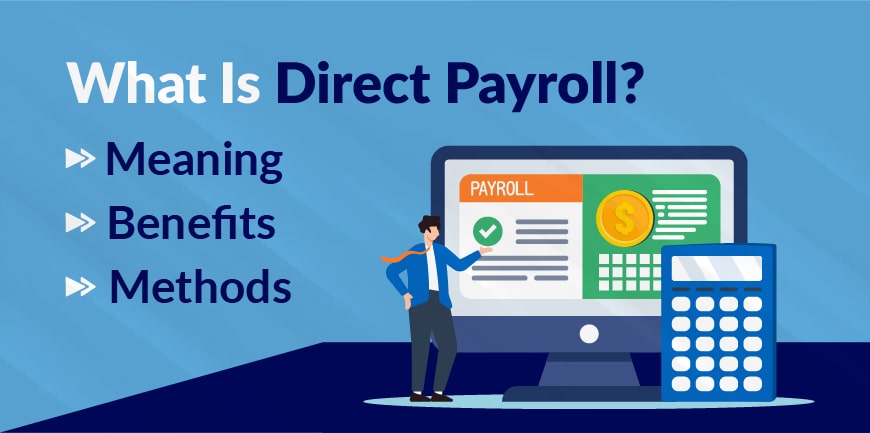
Does Soft Skills Matter as Much as Technical Skills- The Debate
09/06/2025
What is a Head-hunter? Meaning, Definition, Types, Benefits, Methodology
09/06/2025- What is Direct Payroll?
- How Direct Payroll Works?
- What are the Differences Between Direct Payroll vs. Third-Party Payroll?
- What are the Advantages of Direct Payroll?
- What are Common Payroll Disbursement Methods?
- Who is Responsible for Compliance in Direct Payroll?
- Are You Looking for a Payroll Partner?
- Frequently Asked Questions (FAQs)
Payroll management has transitioned from just a standard process for paying salaries to a strategic necessity that can drive a company’s future growth. There are a couple of ways of managing the payroll tasks for employees either direct or through third-party partnerships. Both methods offer distinct advantages that can be leveraged by companies to improve employee trust, gain competitive advantage, and enhance brand reputation.
Let’s go through direct payroll meaning, benefits, methods, and other details in depth to make an informed decision on whether to adopt a direct payroll process or partner with a third-party agency for payroll and compliance management.
What is Direct Payroll?
The direct payroll meaning is straightforward and states that “Direct payroll is a systematic approach where a company running a business performs payroll management tasks such as salary disbursal tax deductions, and compliance through an internal team without the support of any third-party service provider.”
The tasks performed through a direct payroll process include:
- Gather employee details, including names, bank account numbers, tax rates, addresses, PAN, salary structure, etc.
- Track attendance, leaves, working hours, log in and logout.
- Calculate gross pay, net pay, and deductions such as TDS, EPF, ESI, medical insurance, professional tax, etc.
- Salary disbursement, tax filing and payment to respective authorities on time.
- Maintain accurate payroll records and generate compliance reports for internal stakeholders.
How Direct Payroll Works?
According to the direct payroll definition, the organisation itself will take care of end-to-end payroll management from onboarding employees to report generation for proving compliance with the help of an internal payroll team. Here are the steps involved in the direct payroll process:
Pre-Direct Payroll Activities
The steps performed by the internal payroll team before direct payroll calculation include:
1. Onboarding Employees for Direct Payroll
The internal payroll team will onboard workers for payroll and prepare a list of active employees who need to be paid salaries within the approved timeline.
2. Defining Direct Payroll Policy
A detailed payroll policy must be in place to maintain equal standards and transparency. The management must approve this policy before initiating the actual direct payroll process. The components of a direct payroll policy include:
- Salary structure
- Salary disbursal periods and payment credit schedules.
- Tax and other applicable deductions.
- Overtime pay and Leave encashment.
- Attendance and leave data.
- Compliance standards to be met.
- Payroll management system
- Payroll method to be followed.
3. Gather Employee Information
For accurate payroll processing, collecting complete information about every employee is paramount. Some of the details required for direct payroll processing include:
- Employee full name
- Employee’s current and permanent address
- Bank details such as account number, IFSC code, etc.
- PAN number
- Marital status
- Job title
- Salary details
- Attendance data
- Tax and voluntary deductions.
- Applicable overtime and holiday pay.
Once the employee details are entered into the payroll database, they must be verified and validated by the authorised personnel.
Actual Direct Payroll Activities
1. Direct payroll calculation
Based on the verified salary information, the net salary for each employee must be calculated after adjusting the voluntary and tax deductions. The direct payroll calculation is either done manually using Excel sheets or through automated payroll software. The components of net salary calculation include:
- Current CTC (Including approved appraisal)
- Allowances (HRA, internet, etc)
- Prerequisites
- Leave adjustment.
- Professional tax, EPF, and insurance deductions.
- Form-16.
- Bonus, incentives, and overtime pay.
- Employee investment declarations.
Post-Payroll Activities
1. Accounting
The employee salaries to be paid will be recorded through a payroll accounting mechanism as they are considered to be the biggest expense for the company.
2. Salary Disbursal
After ensuring there are sufficient funds in the company’s bank account, the payroll team must process the payments and ensure the net salary payable to the employees is credited to their bank account on time. Once the salary credit is completed, the salary slips with breakup details must be provided to the employees without fail.
3. Compliance and Report Generation
Part of the direct payroll process is to perform statutory deductions such as ESI, PF, professional tax (PT), TDS, etc. These payments must be made to the relevant authorities within the deadline otherwise it will be considered a compliance violation. The tax filing reports must be submitted to government agencies and overall compliance reports must be provided to the internal stakeholders for internal and external auditing.
What are the Differences Between Direct Payroll vs. Third-Party Payroll?
The differences between direct payroll process and third-party payroll process include:
| Aspect | Direct Payroll Process | Third-Party Payroll Process |
| Control & Oversight | Full control over employee data, processing, and compliance within the organization. | Managed externally; limited visibility into detailed payroll operations. |
| Cost Structure | Involves internal HR staff, software, and infrastructure costs. | Includes service charges but may reduce internal operational and staffing expenses. |
| Compliance Responsibility | Employer is fully responsible for tax filing, legal norms, and statutory compliance. | Vendor manages all the payroll tasks along with compliance, reducing legal risks and liabilities for the company. |
| Customization & Flexibility | Allows complete customization of payroll elements, benefits, and deductions. | Limited flexibility: customization depends on provider’s platform and policies. |
| Scalability & Efficiency | May become complex and slower as employee count increases without proper systems. | Easily scalable for rapid growth with streamlined processes and automation. |
What are the Advantages of Direct Payroll?
The key direct payroll benefits include:
1. Complete control over the payroll process
As the direct payroll process is performed by an internal team of the company, the management will have complete ownership of all the payroll operations. This arrangement will ensure transparency, accuracy, instant access to payroll data, control over payment schedules, and freedom to make modifications according to policy changes, etc.
2. Data Security and Confidentiality
As the direct payroll system is controlled in-house, the chances of data breaches and misuse of sensitive employee data are very minimal.
3. Customisation and Flexibility
With direct payroll process done in-house, the salary structure, incentives, and benefits administration can be modified at will without worrying about limitations that typically occur with third-party service providers or software.
4. Real-Time Dispute Resolution
As payroll is processed internally with a direct payroll management, any discrepancy or error can be resolved in real-time without worrying about delays or other issues.
5. Cost Efficiency in Long Term
Although initial investment is high for setting up a direct payroll system, in the long run, it will become more cost-effective.
What are Common Payroll Disbursement Methods?
The payroll disbursement methods followed during the direct payroll process include:
- Direct Deposit: This is the most preferred method of salary disbursal where employees get their salary credited directly to their bank account approved by the company.
- Cheques: Some companies still use paper cheques for salary payments, but these are less convenient as employees must visit the bank every time to deposit the cheque and get their salary credited to their account.
- Cash Payment: While it is very rare for companies to use cash payment mode for salary disbursal, certain small businesses use this method if the number of employees is very low.
- Payroll cards: These are specifically designed debit cards that employees can use for direct access to their salaries without requiring an individual bank account.
- Mobile Payment Solutions: Some firms are looking at possibilities of using mobile payment solutions like UPI payments to pay salaries for employees to facilitate flexibility and on-demand payment.
- Other methods: Some overseas companies operating in India use wire transfers, Bill Pay, and cryptocurrency as salary disbursal methods.
Who is Responsible for Compliance in Direct Payroll?
If a company is following a direct payroll process for managing salaries and proving compliance, then HR and accounting departments are responsible for ensuring all tasks are in-line with laws and regulations applicable to the location of business.
The HR team takes care of employee data, labour and tax law compliance, and employee benefits whereas the payroll or accounting team handles actual direct payroll calculation and tax withholding for every employee.
Moreover, in some companies especially large MNCs, there will be a dedicated team created for managing payroll compliance for the entire organisation.
Are You Looking for a Payroll Partner?
Although the direct payroll method has numerous advantages, managing an in-house team for processing and compliance can be tedious and expensive, especially for medium to large-scale businesses.
Also, for startups managing compliance through a direct payroll process is challenging since they lack the expertise and experience to achieve compliance against ever-changing laws and regulations.
Therefore, it will be a smart decision to partner with a reputed payroll and compliance agency like ALP Consulting who offer end-to-end payroll solutions and take full responsibility to ensure compliance is achieved at all times. The key advantages of collaborating with ALP include:
- Higher ROI
- End-to-end tailored solutions as per business needs.
- A dedicated and expert payroll team for executing seamless payroll processing.
- Cloud-based payroll processing that ensures the protection of sensitive employee data.
- Our payroll solutions are customisable and scalable according to the business size and services.
Frequently Asked Questions (FAQs)
1. How is direct payroll calculated?
Direct payroll calculation is done based on net pay which is gross pay minus the total deductions applicable for a particular employee’s salary structure.
2. What is the difference between direct payroll and indirect payroll?
Direct payroll includes the net pay credited to an employee’s bank account, but indirect payroll includes benefits such as health insurance, paid time off, PF, etc., which have monetary values but are not directly paid to the employees.
3. Can companies use both direct and third-party payroll?
Yes, companies have the liberty to use both direct and third-party payroll based on their business needs and available resources. For instance, a direct payroll process can be used for managing salaries for permanent employees whereas third-party payroll can be used to make salary payments to contracted and temporary workers within an organisation.
4. How does direct payroll affect employee benefits?
The employee benefits under a direct payroll system may be more lucrative for employees whereas benefits under a third party may depend on the agreement between the company and the payroll service provider.
5. What is direct payroll?
The direct payroll meaning in HR states that ” Any company that uses an internal team for end-to-end payroll management and compliance is said to be following a direct payroll approach. In such an arrangement, no third-party providers are used for carrying out any tasks related to payroll or compliance.
6. How does direct payroll differ from third-party payroll?
As per the direct payroll meaning, the entire responsibility of managing payroll and compliance lies with the internal HR and accounting team. On the other hand, a third-party payroll company will have a dedicated team that handles payroll and compliance on behalf of their client company.
Contact Us For Business Enquiry

Yugandhara V. M
Yugandhara V. M serves as the Assistant Vice President – HRO at Alp Consulting Ltd., bringing over 14 years of rich experience in Human Resource Outsourcing, payroll management, and statutory compliance. He specializes in driving process excellence across HR operations, ensuring seamless service delivery and compliance with labor laws. Yugandhara’s expertise lies in managing large-scale client engagements, optimizing HR processes, and implementing efficient workforce management systems that enhance organizational performance. He also leads comprehensive payroll services, ensuring accuracy, timeliness, and compliance for diverse client portfolios.




